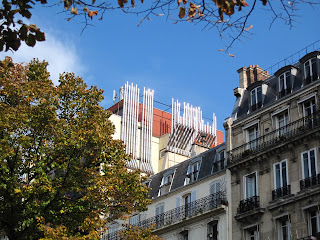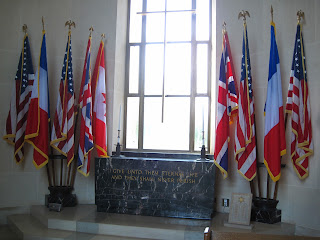The excursion to Normandy on the northwest coast of France to see the D-Day Landing Beaches and American Cemetery was extraordinary. We've wanted to do this but were unsure if I could manage the long drive. As it turned out, the drive wasn't bad and the scenery along the way made the time fly.
Our first stop was Caen to visit the Memorial. This museum was the most extensive and detailed account of the time leading up to World War II, beginning with the end of World War I, to the rise of Hitler, the persecution of the Jewish people and progression of the war leading to the Battle of Normandy. There were very graphic photos, film clips of the bombing of London and the allied invasion on June 6th.
I had read a really good book before our trip by Erik Larson titled "
In the Garden of Beasts". The true story tells about the rise of Hitler in Germany from the viewpoint of the American ambassador in Berlin. The museum confirmed Larson's account, in a very dramatic way.
The end of the "Great War". Europe was devasted. The militaries were depleted, cities and countries destroyed and there were an incredible number of casualities.
Because of the terrible toll that the war had on the allies and the humiliation that Germany experienced in losing, it was the perfect climate for Hitler to begin his rise and take over of the government. It wasn't that it wasn't noticed; it was never acted upon. The French and British were war weary, their military was depleted and the world wide economic depression added to the increasing power that Hitler's ideas had over the German people.
Accounts of the systematic persecution and extermination of the Jews were harrowing.
As much as we've heard and read of the Holocaust, it did not prepare me for these exhibits. I saw and read about more than I ever knew; it was so appalling and gruesome that I had to pass by much of that part of the exhibit.
Most dramatic for me was actual film footage of the bombing of London. There was a small viewing room, darkened with only the projection screen. You saw and heard the bombing...it was incredibly "real".
The
D-Day offensive was awesome. I had no recollection from history classes the magnitude of the Allied invasion forces. The actual war film footage was incredible. The naval fleet was over 6000 vessels. Airborne troops numbered 25,000. The invasion was co-ordinated with the French resistance in France. There were more than 195,000 land, air and sea troops in the operations headed by Generals Eisenhower & Montgomery. The landings took place along a 50 mile stretch of the Normandy coast that was divided into 5 sectors;
Utah, Omaha, Juno, Gold and
Sword.
After a superb sit-down lunch with wine, we boarded the bus to view the beaches.
Utah Beach
I was not prepared for what I was seeing. The landscaped littered with huge bomb craters. Even though they were covered with grass, the enormity was quite evident.
Also the number of bunkers remaining was surprising. Simply staggering.
Then there were the cliffs. The landing footage at the Memorial showed the troops maneuvering these cliffs. Seeing it was mind boggling. You can only imagine what the troops were going through trying to scale these cliffs. Because the actual landing site was missed to the southeast and due to the paratroopers that landed as well, this operation had the least number of casualites.
On the way to Omaha beach, we stopped at Arromanches. The site of Mulberry Harbor, an artificial harbor built of huge concrete slabs that were shipped across the English Channel. Since there were no natural harbors in the area, an artificial harbor had to built for unloading cargo.
Part of the Mulberry Harbor remaining.
One of the concrete slabs used to build the artificial harbor.
Omaha Beach
The primary objective of the landing was to secure the area of the beach linking the British landings at Gold Beach to the east and Utah Beach to the west. Very little went as planned during the landing at Omaha. Omaha was the most heavily fortified beach. Difficulties in navigation resulted in most of the landings to drift eastward, missing the targeted area. American casualites numbered 5000. It took 3 days to secure the beach.



Omaha Beach Memorial
On the way to the Amercian Cemetery at Colleville, we drove through the beautiful Normandy countryside. The roads were very narrow for our oversized tour bus.
The cemetery sits up on a bluff overlooking Omaha Beach. It is an awesome site; somber, reverent and poignant.
While we were walking passed the pool, the chimes began to play the "Star Spangled Banner". Everyone stopped where they were and focused on the two flag poles. When the anthem was done, "Taps" was played. We weren't sure what the occasion was but the response was quite emotional.
Overlooking Omaha beach
"Here rest in honored glory A COMRADE IN ARMS known but to God"
There were so many graves marked like this.
From the cemetery we drove further east to Juno Beach. This beach was taken by the Canadian forces and it is also the site of the French Resistance Memorial.
Juno Beach
The thought provoking wall leading passed the large bunker on the way to the beach.
The French Resistance Memorial
The French Resistance was key in the success of the D-day mission.
This day (and tour) was the best history lesson. We, as Americans, have no concept of what it means to be "occupied" by a hostile force. The respect and honor given to the Allied Forces is evident everywhere.
Emotions ran high today~ extreme pride and sadness. This day will be a long held memory.





































































